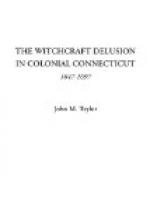Those of the Inquisitor General, Eymeric, in 1359, entitled Tractatus contra daemonum; the Formicarius or Ant Hill of the German Dominican Nider, 1337; the De calcatione daemonum, 1452; the Flagellum haereticorum fascinariorum of the French Inquisitor Jaquier in 1458; and the Fortalitium fidei of the Spanish Franciscan Alonso de Spina, in 1459; the famous and infamous manual of arguments and rules of procedure for the detection and punishment of witches, compiled by the German Inquisitors Kraemer and Sprenger (Institor) in 1489, buttressed on the bull of Pope Innocent VIII; (this was the celebrated Witch Hammer, bearing on its title page the significant legend, “Not to believe in witchcraft is the greatest of heresies"); the Canon Episcopi; the bulls of Popes John XXII, 1330, Innocent VIII, 1484, Alexander VI, 1494, Leo X, 1521, and Adrian VI, 1522; the Decretals of the canon law; the exorcisms of the Roman and Greek churches, all hinged on scriptural precedents; the Roman law, the Twelve Tables, and the Justinian Code, the last three imposing upon the crimes of conjuring, exorcising, magical arts, offering sacrifices to the injury of one’s neighbors, sorcery, and witchcraft, the penalties of death by torture, fire, or crucifixion.
Add to these classics some of the later authorities: the Daemonologie of the royal inquisitor James I of England and Scotland, 1597; Mores’ Antidote to Atheism; Fuller’s Holy and Profane State; Granvil’s Sadducismus Triumphatus, 1681; Tryal of Witches at the Assizes for the County of Suffolk before Sir Matthew Hale, March, 1664 (London, 1682); Baxter’s Certainty of the World of Spirits, 1691; Cotton Mather’s A Discourse on Witchcraft, 1689, his Late Memorable Providences Relating to Witchcrafts and Possessions, 1684, and his Wonders of the Invisible World, 1692; and enough references have been made to this literature of delusion, to the precedents that seared the consciences of courts and juries in their sentences of men, women, and children to death by the rack, the wheel, the stake, and the gallows.
Where in history are the horrors of the curse more graphically told than in the words of Canon Linden, an eye witness of the demonic deeds at Trier (Treves) in 1589?
“And so, from court to court throughout the towns and villages of all the diocese, scurried special accusers, inquisitors, notaries, jurors, judges, constables, dragging to trial and torture human beings of both sexes and burning them in great numbers. Scarcely any of those who were accused escaped punishment. Nor were there spared even the leading men in the city of Trier. For the Judge, with two Burgomasters, several Councilors and Associate Judges, canons of sundry collegiate churches, parish-priests, rural deans, were swept away in this ruin. So far, at length, did the madness of the furious populace and of the courts go in this thirst for blood and booty that there was scarcely anybody who was not smirched by some suspicion of this crime.




